Subprime Financial Crisis and its Worldwide Impact
VerifiedAdded on 2023/06/11
|7
|1917
|345
AI Summary
This report discusses the subprime financial crisis that occurred in the US from 2007 to 2010, its worldwide impact, policy responses, and how to gain from the market event. It highlights the macroeconomic environment before, during, and after the crisis and the regulatory developments. The report also examines the impact of major financial crises on asset values, production, and employment. The subject is Financial Markets & Institutions, and the course code is 7FNCE011W.
Contribute Materials
Your contribution can guide someone’s learning journey. Share your
documents today.

FINANCIAL
MARKETS &
INSTITUTIONS
7FNCE011W
COURSEWORK
MARKETS &
INSTITUTIONS
7FNCE011W
COURSEWORK
Secure Best Marks with AI Grader
Need help grading? Try our AI Grader for instant feedback on your assignments.
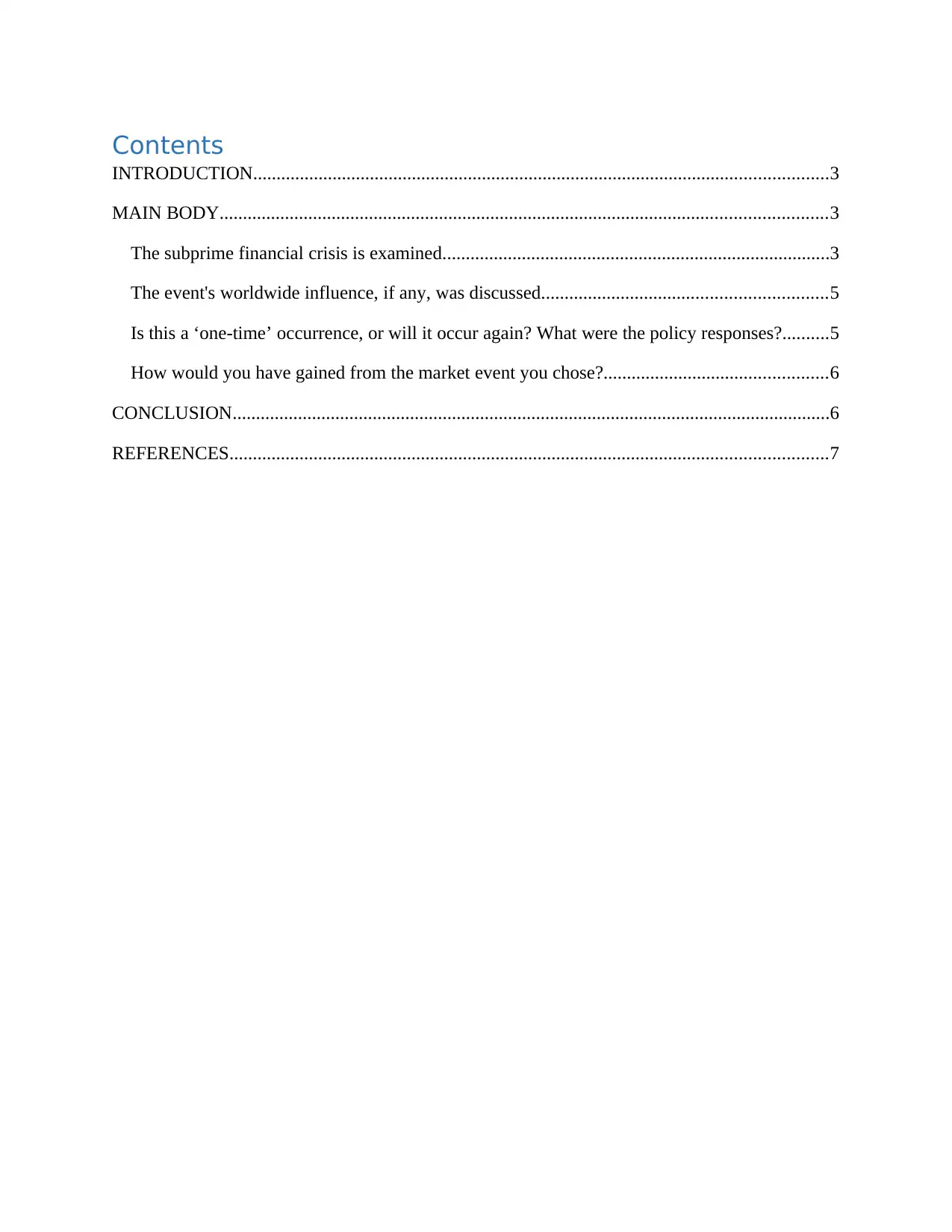
Contents
INTRODUCTION...........................................................................................................................3
MAIN BODY..................................................................................................................................3
The subprime financial crisis is examined...................................................................................3
The event's worldwide influence, if any, was discussed.............................................................5
Is this a ‘one-time’ occurrence, or will it occur again? What were the policy responses?..........5
How would you have gained from the market event you chose?................................................6
CONCLUSION................................................................................................................................6
REFERENCES................................................................................................................................7
INTRODUCTION...........................................................................................................................3
MAIN BODY..................................................................................................................................3
The subprime financial crisis is examined...................................................................................3
The event's worldwide influence, if any, was discussed.............................................................5
Is this a ‘one-time’ occurrence, or will it occur again? What were the policy responses?..........5
How would you have gained from the market event you chose?................................................6
CONCLUSION................................................................................................................................6
REFERENCES................................................................................................................................7
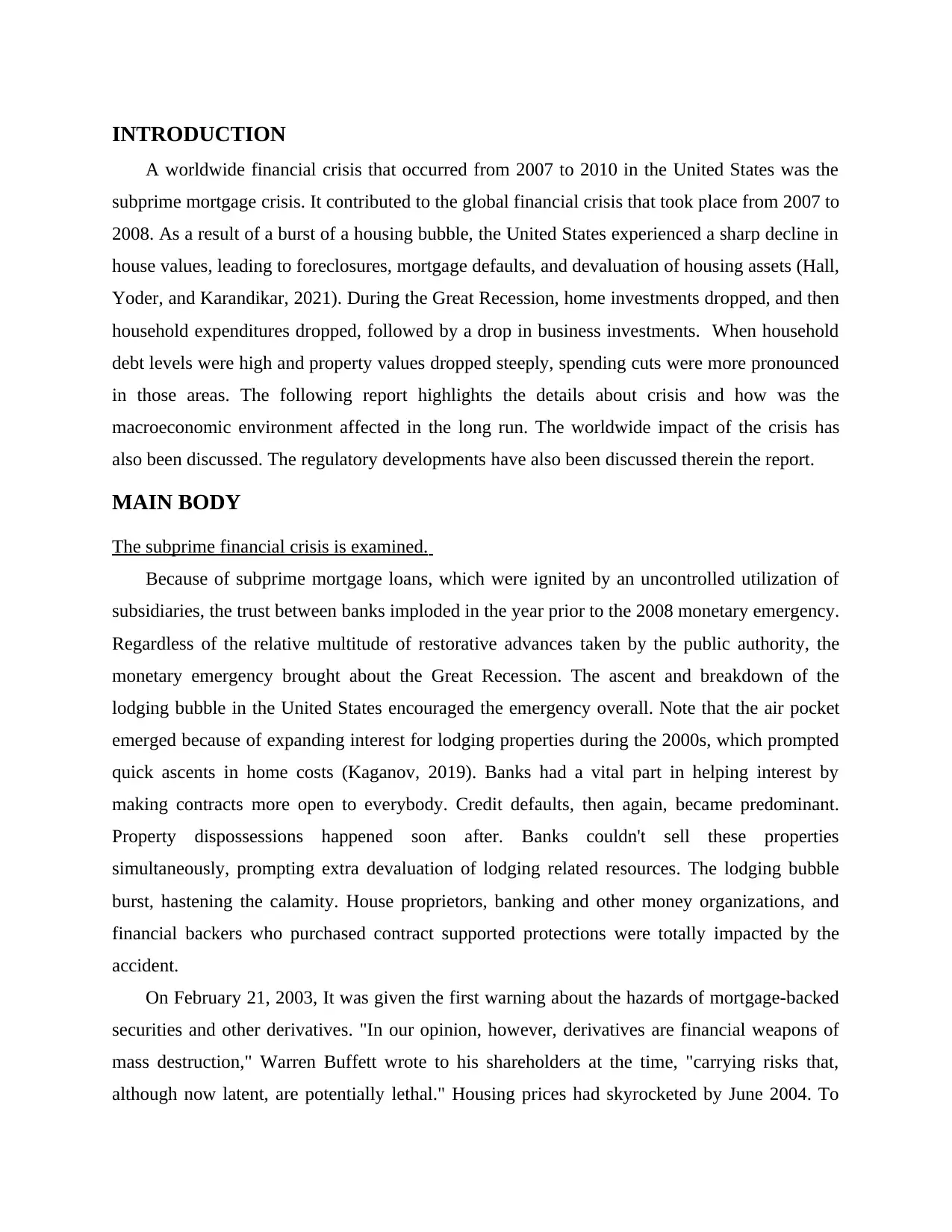
INTRODUCTION
A worldwide financial crisis that occurred from 2007 to 2010 in the United States was the
subprime mortgage crisis. It contributed to the global financial crisis that took place from 2007 to
2008. As a result of a burst of a housing bubble, the United States experienced a sharp decline in
house values, leading to foreclosures, mortgage defaults, and devaluation of housing assets (Hall,
Yoder, and Karandikar, 2021). During the Great Recession, home investments dropped, and then
household expenditures dropped, followed by a drop in business investments. When household
debt levels were high and property values dropped steeply, spending cuts were more pronounced
in those areas. The following report highlights the details about crisis and how was the
macroeconomic environment affected in the long run. The worldwide impact of the crisis has
also been discussed. The regulatory developments have also been discussed therein the report.
MAIN BODY
The subprime financial crisis is examined.
Because of subprime mortgage loans, which were ignited by an uncontrolled utilization of
subsidiaries, the trust between banks imploded in the year prior to the 2008 monetary emergency.
Regardless of the relative multitude of restorative advances taken by the public authority, the
monetary emergency brought about the Great Recession. The ascent and breakdown of the
lodging bubble in the United States encouraged the emergency overall. Note that the air pocket
emerged because of expanding interest for lodging properties during the 2000s, which prompted
quick ascents in home costs (Kaganov, 2019). Banks had a vital part in helping interest by
making contracts more open to everybody. Credit defaults, then again, became predominant.
Property dispossessions happened soon after. Banks couldn't sell these properties
simultaneously, prompting extra devaluation of lodging related resources. The lodging bubble
burst, hastening the calamity. House proprietors, banking and other money organizations, and
financial backers who purchased contract supported protections were totally impacted by the
accident.
On February 21, 2003, It was given the first warning about the hazards of mortgage-backed
securities and other derivatives. "In our opinion, however, derivatives are financial weapons of
mass destruction," Warren Buffett wrote to his shareholders at the time, "carrying risks that,
although now latent, are potentially lethal." Housing prices had skyrocketed by June 2004. To
A worldwide financial crisis that occurred from 2007 to 2010 in the United States was the
subprime mortgage crisis. It contributed to the global financial crisis that took place from 2007 to
2008. As a result of a burst of a housing bubble, the United States experienced a sharp decline in
house values, leading to foreclosures, mortgage defaults, and devaluation of housing assets (Hall,
Yoder, and Karandikar, 2021). During the Great Recession, home investments dropped, and then
household expenditures dropped, followed by a drop in business investments. When household
debt levels were high and property values dropped steeply, spending cuts were more pronounced
in those areas. The following report highlights the details about crisis and how was the
macroeconomic environment affected in the long run. The worldwide impact of the crisis has
also been discussed. The regulatory developments have also been discussed therein the report.
MAIN BODY
The subprime financial crisis is examined.
Because of subprime mortgage loans, which were ignited by an uncontrolled utilization of
subsidiaries, the trust between banks imploded in the year prior to the 2008 monetary emergency.
Regardless of the relative multitude of restorative advances taken by the public authority, the
monetary emergency brought about the Great Recession. The ascent and breakdown of the
lodging bubble in the United States encouraged the emergency overall. Note that the air pocket
emerged because of expanding interest for lodging properties during the 2000s, which prompted
quick ascents in home costs (Kaganov, 2019). Banks had a vital part in helping interest by
making contracts more open to everybody. Credit defaults, then again, became predominant.
Property dispossessions happened soon after. Banks couldn't sell these properties
simultaneously, prompting extra devaluation of lodging related resources. The lodging bubble
burst, hastening the calamity. House proprietors, banking and other money organizations, and
financial backers who purchased contract supported protections were totally impacted by the
accident.
On February 21, 2003, It was given the first warning about the hazards of mortgage-backed
securities and other derivatives. "In our opinion, however, derivatives are financial weapons of
mass destruction," Warren Buffett wrote to his shareholders at the time, "carrying risks that,
although now latent, are potentially lethal." Housing prices had skyrocketed by June 2004. To
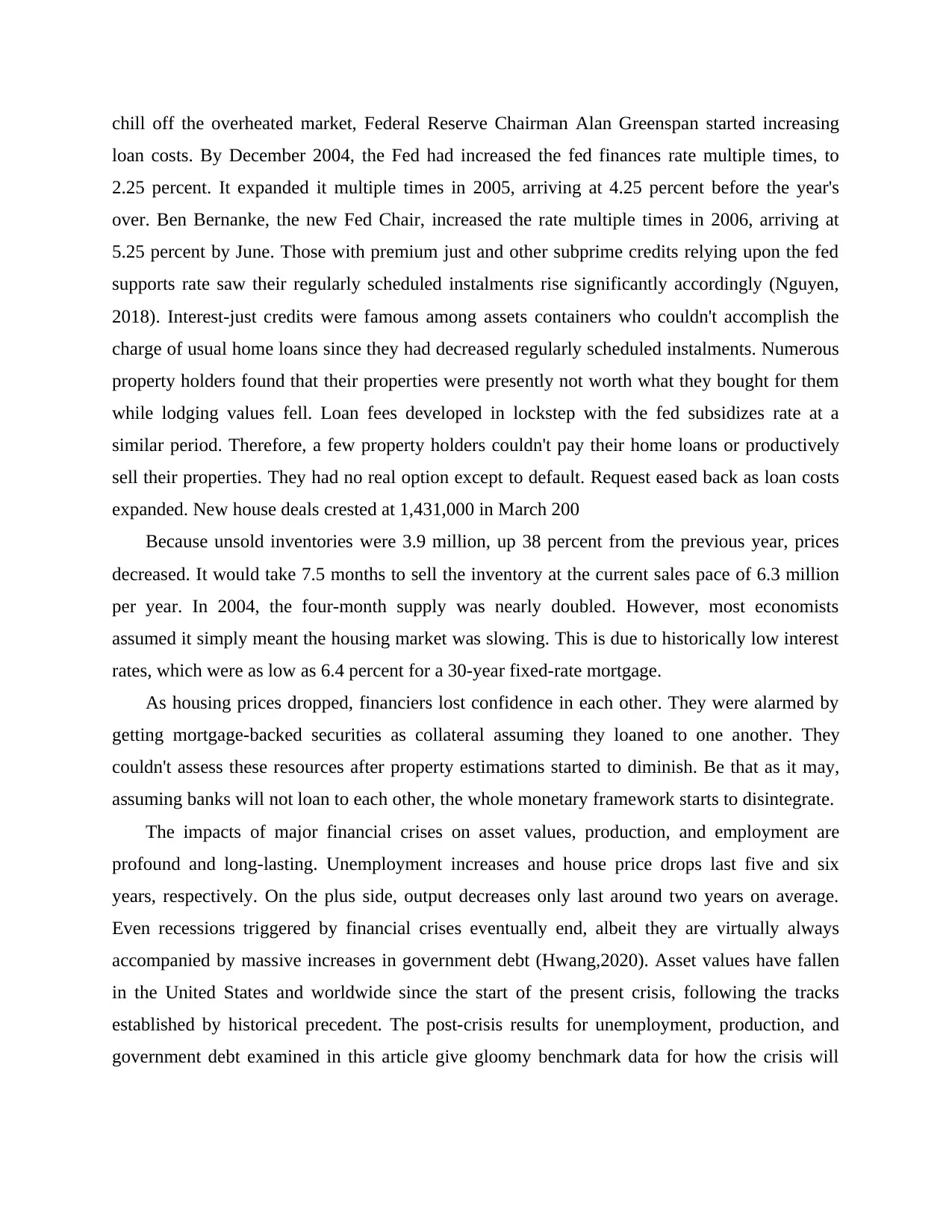
chill off the overheated market, Federal Reserve Chairman Alan Greenspan started increasing
loan costs. By December 2004, the Fed had increased the fed finances rate multiple times, to
2.25 percent. It expanded it multiple times in 2005, arriving at 4.25 percent before the year's
over. Ben Bernanke, the new Fed Chair, increased the rate multiple times in 2006, arriving at
5.25 percent by June. Those with premium just and other subprime credits relying upon the fed
supports rate saw their regularly scheduled instalments rise significantly accordingly (Nguyen,
2018). Interest-just credits were famous among assets containers who couldn't accomplish the
charge of usual home loans since they had decreased regularly scheduled instalments. Numerous
property holders found that their properties were presently not worth what they bought for them
while lodging values fell. Loan fees developed in lockstep with the fed subsidizes rate at a
similar period. Therefore, a few property holders couldn't pay their home loans or productively
sell their properties. They had no real option except to default. Request eased back as loan costs
expanded. New house deals crested at 1,431,000 in March 200
Because unsold inventories were 3.9 million, up 38 percent from the previous year, prices
decreased. It would take 7.5 months to sell the inventory at the current sales pace of 6.3 million
per year. In 2004, the four-month supply was nearly doubled. However, most economists
assumed it simply meant the housing market was slowing. This is due to historically low interest
rates, which were as low as 6.4 percent for a 30-year fixed-rate mortgage.
As housing prices dropped, financiers lost confidence in each other. They were alarmed by
getting mortgage-backed securities as collateral assuming they loaned to one another. They
couldn't assess these resources after property estimations started to diminish. Be that as it may,
assuming banks will not loan to each other, the whole monetary framework starts to disintegrate.
The impacts of major financial crises on asset values, production, and employment are
profound and long-lasting. Unemployment increases and house price drops last five and six
years, respectively. On the plus side, output decreases only last around two years on average.
Even recessions triggered by financial crises eventually end, albeit they are virtually always
accompanied by massive increases in government debt (Hwang,2020). Asset values have fallen
in the United States and worldwide since the start of the present crisis, following the tracks
established by historical precedent. The post-crisis results for unemployment, production, and
government debt examined in this article give gloomy benchmark data for how the crisis will
loan costs. By December 2004, the Fed had increased the fed finances rate multiple times, to
2.25 percent. It expanded it multiple times in 2005, arriving at 4.25 percent before the year's
over. Ben Bernanke, the new Fed Chair, increased the rate multiple times in 2006, arriving at
5.25 percent by June. Those with premium just and other subprime credits relying upon the fed
supports rate saw their regularly scheduled instalments rise significantly accordingly (Nguyen,
2018). Interest-just credits were famous among assets containers who couldn't accomplish the
charge of usual home loans since they had decreased regularly scheduled instalments. Numerous
property holders found that their properties were presently not worth what they bought for them
while lodging values fell. Loan fees developed in lockstep with the fed subsidizes rate at a
similar period. Therefore, a few property holders couldn't pay their home loans or productively
sell their properties. They had no real option except to default. Request eased back as loan costs
expanded. New house deals crested at 1,431,000 in March 200
Because unsold inventories were 3.9 million, up 38 percent from the previous year, prices
decreased. It would take 7.5 months to sell the inventory at the current sales pace of 6.3 million
per year. In 2004, the four-month supply was nearly doubled. However, most economists
assumed it simply meant the housing market was slowing. This is due to historically low interest
rates, which were as low as 6.4 percent for a 30-year fixed-rate mortgage.
As housing prices dropped, financiers lost confidence in each other. They were alarmed by
getting mortgage-backed securities as collateral assuming they loaned to one another. They
couldn't assess these resources after property estimations started to diminish. Be that as it may,
assuming banks will not loan to each other, the whole monetary framework starts to disintegrate.
The impacts of major financial crises on asset values, production, and employment are
profound and long-lasting. Unemployment increases and house price drops last five and six
years, respectively. On the plus side, output decreases only last around two years on average.
Even recessions triggered by financial crises eventually end, albeit they are virtually always
accompanied by massive increases in government debt (Hwang,2020). Asset values have fallen
in the United States and worldwide since the start of the present crisis, following the tracks
established by historical precedent. The post-crisis results for unemployment, production, and
government debt examined in this article give gloomy benchmark data for how the crisis will
Secure Best Marks with AI Grader
Need help grading? Try our AI Grader for instant feedback on your assignments.
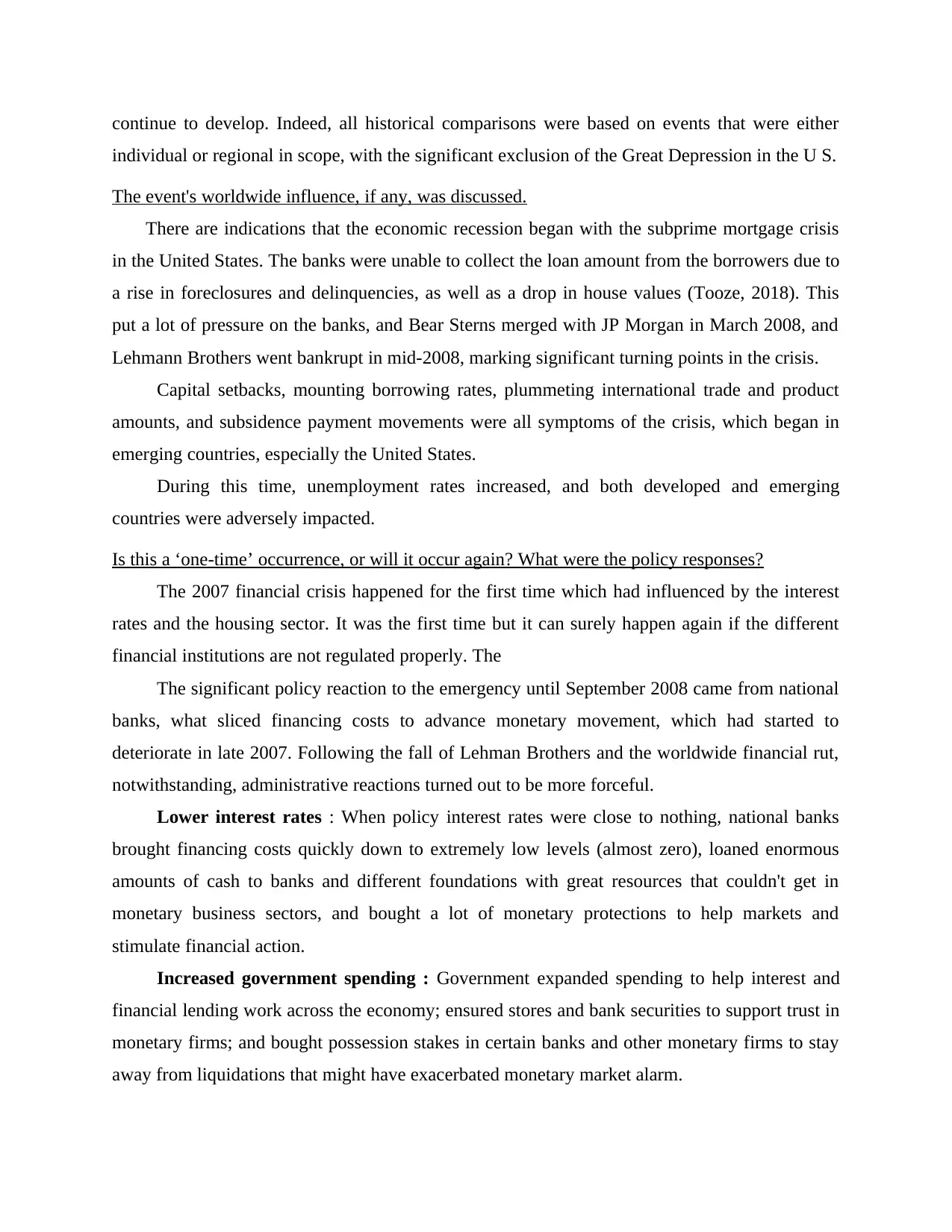
continue to develop. Indeed, all historical comparisons were based on events that were either
individual or regional in scope, with the significant exclusion of the Great Depression in the U S.
The event's worldwide influence, if any, was discussed.
There are indications that the economic recession began with the subprime mortgage crisis
in the United States. The banks were unable to collect the loan amount from the borrowers due to
a rise in foreclosures and delinquencies, as well as a drop in house values (Tooze, 2018). This
put a lot of pressure on the banks, and Bear Sterns merged with JP Morgan in March 2008, and
Lehmann Brothers went bankrupt in mid-2008, marking significant turning points in the crisis.
Capital setbacks, mounting borrowing rates, plummeting international trade and product
amounts, and subsidence payment movements were all symptoms of the crisis, which began in
emerging countries, especially the United States.
During this time, unemployment rates increased, and both developed and emerging
countries were adversely impacted.
Is this a ‘one-time’ occurrence, or will it occur again? What were the policy responses?
The 2007 financial crisis happened for the first time which had influenced by the interest
rates and the housing sector. It was the first time but it can surely happen again if the different
financial institutions are not regulated properly. The
The significant policy reaction to the emergency until September 2008 came from national
banks, what sliced financing costs to advance monetary movement, which had started to
deteriorate in late 2007. Following the fall of Lehman Brothers and the worldwide financial rut,
notwithstanding, administrative reactions turned out to be more forceful.
Lower interest rates : When policy interest rates were close to nothing, national banks
brought financing costs quickly down to extremely low levels (almost zero), loaned enormous
amounts of cash to banks and different foundations with great resources that couldn't get in
monetary business sectors, and bought a lot of monetary protections to help markets and
stimulate financial action.
Increased government spending : Government expanded spending to help interest and
financial lending work across the economy; ensured stores and bank securities to support trust in
monetary firms; and bought possession stakes in certain banks and other monetary firms to stay
away from liquidations that might have exacerbated monetary market alarm.
individual or regional in scope, with the significant exclusion of the Great Depression in the U S.
The event's worldwide influence, if any, was discussed.
There are indications that the economic recession began with the subprime mortgage crisis
in the United States. The banks were unable to collect the loan amount from the borrowers due to
a rise in foreclosures and delinquencies, as well as a drop in house values (Tooze, 2018). This
put a lot of pressure on the banks, and Bear Sterns merged with JP Morgan in March 2008, and
Lehmann Brothers went bankrupt in mid-2008, marking significant turning points in the crisis.
Capital setbacks, mounting borrowing rates, plummeting international trade and product
amounts, and subsidence payment movements were all symptoms of the crisis, which began in
emerging countries, especially the United States.
During this time, unemployment rates increased, and both developed and emerging
countries were adversely impacted.
Is this a ‘one-time’ occurrence, or will it occur again? What were the policy responses?
The 2007 financial crisis happened for the first time which had influenced by the interest
rates and the housing sector. It was the first time but it can surely happen again if the different
financial institutions are not regulated properly. The
The significant policy reaction to the emergency until September 2008 came from national
banks, what sliced financing costs to advance monetary movement, which had started to
deteriorate in late 2007. Following the fall of Lehman Brothers and the worldwide financial rut,
notwithstanding, administrative reactions turned out to be more forceful.
Lower interest rates : When policy interest rates were close to nothing, national banks
brought financing costs quickly down to extremely low levels (almost zero), loaned enormous
amounts of cash to banks and different foundations with great resources that couldn't get in
monetary business sectors, and bought a lot of monetary protections to help markets and
stimulate financial action.
Increased government spending : Government expanded spending to help interest and
financial lending work across the economy; ensured stores and bank securities to support trust in
monetary firms; and bought possession stakes in certain banks and other monetary firms to stay
away from liquidations that might have exacerbated monetary market alarm.

Financial corporations were subjected to more strict regulations: In response to the crisis,
regulators increased their monitoring of banks and other financial institutions. Among a number
of new international laws, banks must now analyze the risk of the loans they make and use more
solid funding sources. In this situation, banks are forced to operate with less leverage and are no
longer able to provide as many short-term loans to their customers. The regulatory community is
also becoming more aware of the ways in which risks can spread across financial systems, and
they demand steps to prevent it.
How would you have gained from the market event you chose?
Cash instruments, shares and debentures are some of the financial instruments which would
have been used to gain from the 2008 market event as it clear that the downfall of the market was
seen mainly due to the mortgages and the extensive use of derivatives which resulted in the
decline of trust among the lenders (Mesly, and et.al., 2020).
CONCLUSION
The above report highlights the detailed study of how the subprime crisis happened and what
were the financial environment before, during and after the crisis had happened in the US. It can
be concluded that such crisis can happen again if there are no critical regulations to manage the
financial markets and the derivatives in the country. This crisis has also had an impact on the
countries worldwide and it mainly resulted in lack of available resources and reduced
employment in the countries worldwide.
regulators increased their monitoring of banks and other financial institutions. Among a number
of new international laws, banks must now analyze the risk of the loans they make and use more
solid funding sources. In this situation, banks are forced to operate with less leverage and are no
longer able to provide as many short-term loans to their customers. The regulatory community is
also becoming more aware of the ways in which risks can spread across financial systems, and
they demand steps to prevent it.
How would you have gained from the market event you chose?
Cash instruments, shares and debentures are some of the financial instruments which would
have been used to gain from the 2008 market event as it clear that the downfall of the market was
seen mainly due to the mortgages and the extensive use of derivatives which resulted in the
decline of trust among the lenders (Mesly, and et.al., 2020).
CONCLUSION
The above report highlights the detailed study of how the subprime crisis happened and what
were the financial environment before, during and after the crisis had happened in the US. It can
be concluded that such crisis can happen again if there are no critical regulations to manage the
financial markets and the derivatives in the country. This crisis has also had an impact on the
countries worldwide and it mainly resulted in lack of available resources and reduced
employment in the countries worldwide.
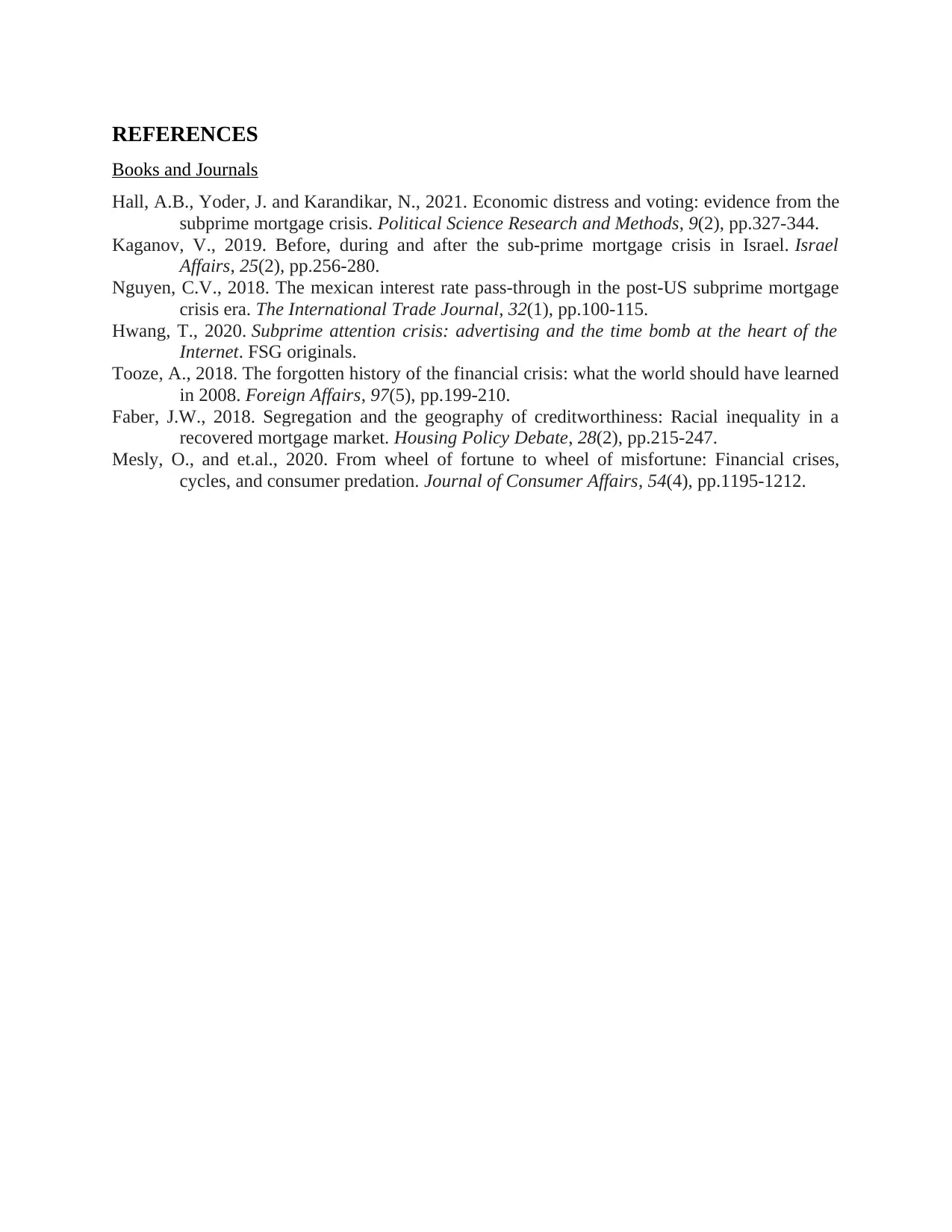
REFERENCES
Books and Journals
Hall, A.B., Yoder, J. and Karandikar, N., 2021. Economic distress and voting: evidence from the
subprime mortgage crisis. Political Science Research and Methods, 9(2), pp.327-344.
Kaganov, V., 2019. Before, during and after the sub-prime mortgage crisis in Israel. Israel
Affairs, 25(2), pp.256-280.
Nguyen, C.V., 2018. The mexican interest rate pass-through in the post-US subprime mortgage
crisis era. The International Trade Journal, 32(1), pp.100-115.
Hwang, T., 2020. Subprime attention crisis: advertising and the time bomb at the heart of the
Internet. FSG originals.
Tooze, A., 2018. The forgotten history of the financial crisis: what the world should have learned
in 2008. Foreign Affairs, 97(5), pp.199-210.
Faber, J.W., 2018. Segregation and the geography of creditworthiness: Racial inequality in a
recovered mortgage market. Housing Policy Debate, 28(2), pp.215-247.
Mesly, O., and et.al., 2020. From wheel of fortune to wheel of misfortune: Financial crises,
cycles, and consumer predation. Journal of Consumer Affairs, 54(4), pp.1195-1212.
Books and Journals
Hall, A.B., Yoder, J. and Karandikar, N., 2021. Economic distress and voting: evidence from the
subprime mortgage crisis. Political Science Research and Methods, 9(2), pp.327-344.
Kaganov, V., 2019. Before, during and after the sub-prime mortgage crisis in Israel. Israel
Affairs, 25(2), pp.256-280.
Nguyen, C.V., 2018. The mexican interest rate pass-through in the post-US subprime mortgage
crisis era. The International Trade Journal, 32(1), pp.100-115.
Hwang, T., 2020. Subprime attention crisis: advertising and the time bomb at the heart of the
Internet. FSG originals.
Tooze, A., 2018. The forgotten history of the financial crisis: what the world should have learned
in 2008. Foreign Affairs, 97(5), pp.199-210.
Faber, J.W., 2018. Segregation and the geography of creditworthiness: Racial inequality in a
recovered mortgage market. Housing Policy Debate, 28(2), pp.215-247.
Mesly, O., and et.al., 2020. From wheel of fortune to wheel of misfortune: Financial crises,
cycles, and consumer predation. Journal of Consumer Affairs, 54(4), pp.1195-1212.
1 out of 7
Related Documents
Your All-in-One AI-Powered Toolkit for Academic Success.
+13062052269
info@desklib.com
Available 24*7 on WhatsApp / Email
![[object Object]](/_next/static/media/star-bottom.7253800d.svg)
Unlock your academic potential
© 2024 | Zucol Services PVT LTD | All rights reserved.





